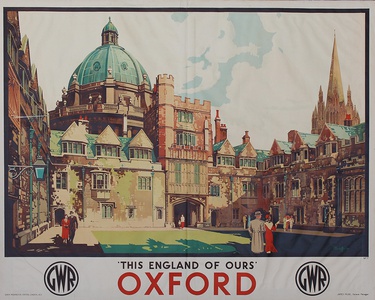| Method | Chromolithograph |
| Artist | Claude Buckle |
| Published | Printed in England by the Dangerfield Printing Co LTD, London. c. 1932 |
| Dimensions | Image 906 x 1215 mm, Sheet 1015 x 1265 mm |
| Notes |
One of the scarcest and most iconic Oxford rail posters depicting a stylised 1930's view from the quad of Brasenose College with the dome of the Radcliffe Camera behind and the spire of The University Church of St Mary the Virgin to the right. This is one of the first railway posters produced by Claude Buckle, one of most prolific and recognisable designers of British travel posters, producing over a 100 published images. The original watercolour for this design is held by the National Railway Museum (Science Museum Group: 2000-7748). The title of the series of travel posters is printed below, flanked by the GWR logo on either side. Signed within the image and inscribed at the bottom of the sheet "GWR, Paddington Station, London, W2", "JAMES MILNE, General Manager". This design was also available as a puzzle. The story of railways in Britain is reflected in the development of the railway poster. This commercial art form illustrates the major changes that have occurred in British society over the years and captures the spirit and character of British life. They are social documents of British culture, illustrating the changing styles of art, patterns of holiday making, urban and rural landscapes, architecture and fashion. They also reflect the development of railway companies and their design and advertising standards. It is hardly surprising that the "Golden Age" of British railway posters coincided with the quarter-century following the amalgamation in 1923 of almost all of the numerous small independent companies into what came to be known as the "Big Four" railways: the Great Western (GWR); the London, Midland, and Scottish (LMS); the London and North East (LNER); and the Southern (SR). The end of the Great War saw Britain with a public eager to travel - and possessing a well-developed taste for the poster as a medium of advertising. In the latter case the war itself provided continuity for initiatives that began in peacetime, for the recruiting and saving and funding campaigns needed to vanquish the Hun were waged largely on the hoardings. Nor is it surprising that the main visual thrust of the railway poster campaigns during these years was directed towards the anticipated delights of journey's end, and copies of posters were routinely offered to - and eagerly purchased by - the public, some of whom might indeed have to settle more often for an idyllic image of Britain's coasts or mountains in their rooms than for the real thing. (Information from: Livingston, A. and Livingston, I., Dictionary of Graphic Design and Designers, 1992, p.187, London Transport Museum Database, February 2000, quoting Riddell, 1994, Darracott, J. and Loftus, B., Second World War Posters, 1981 (1972), p.55) Condition: Excellent original printed colour. Pressed vertical centre fold. Framing tape around edges and centre fold on verso. Small surface abrasion to bottom of black printed border. Light creasing to sheet. |
| Framing | unmounted |
| Price | £3,500.00 |
| Stock ID | 52620 |

